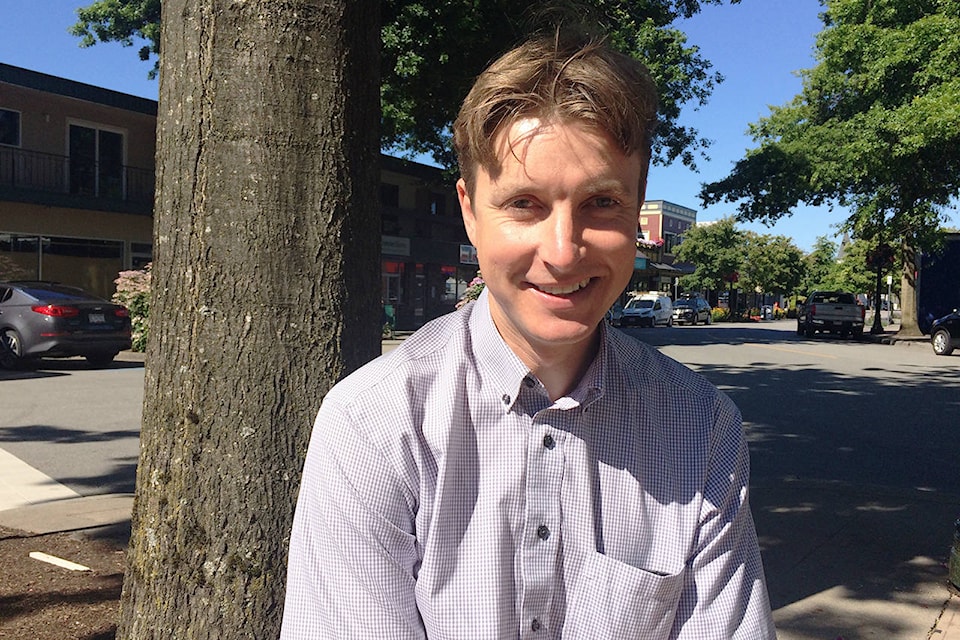When David Bradley looks out the window, he sees birds. He can’t help it. He’s drawn to them.
“They’re everywhere,” the former Delta resident said. “They everywhere and you can’t help but engage with them.”
As a program manager for the B.C. area at Bird Studies Canada, Bradley spends his days thinking about birds. It’s a continuation of how he grew up, following his parents on bird-watching expeditions.
But now, Bradley doesn’t just watch them; he tries to save them. At his job with Bird Studies Canada, Bradley organizes volunteers to do nationally-recognized bird counts, works as a go-between for NGOs and government agencies, and spearheads research projects on B.C. birds.
Often, Bradley can be found at his office next to the George C. Reifel Migratory Bird Sanctuary in Delta. But sometimes, he is out in the field working to protect birds in their natural habitat — and it is this work that Bradley will be talking about at the International Ornithological Congress happening in Vancouver from Aug. 18 to 26.
RELATED: Delta to showcase local birds, but won’t call itself Canada’s raptor capital
Held once every four years, the congress is the largest international gathering of bird scientists in the world. For one week, bird specialists and enthusiasts come together to share their knowledge about conservation and research. Some of this sharing comes in the form of symposiums, one of which Bradley will be hosting with New Zealand’s Elaine Murphy.
Though long, the title of his talk, “Advances in Biosecurity to Reverse Invasive Alien Species Impacts on Islands,” speaks to an important issue affecting bird conservation around the world.
To understand it better, we travel to Haida Gwaii in the early 1700s.
At that time, the isolated island archipelago was a haven for nesting seabirds. Ancient murrelets, after nesting in burrows and rock crevices for just over a month, formed giant colonies that shepherded their newborn chicks to the sea. The stocky Cassin’s auklet squealed and peeped from their burrows, while the puffin-like rhinoceros auklet carried fish to its young. Leach’s and fork-tailed storm petrels danced over the sea in displays of dark and silver grey.
In the 1770s, their home was spotted by Europeans, and by the 1780s, Norway rats and black rats had made their way on the island beaches, escaping from the ships they had travelled on.
The rats decimated the seabird populations; the ancient murrelets alone lost 90 per cent of their population by 1988. And other introduced species have wreaked havoc too.
In the 1940s, raccoons were introduced to supplement the fur trade on the islands and eventually became responsible for several seabird colonies abandoning their nesting sites. In 1991, three raccoons killed 72 ancient murrelets and caused another 120 to fail to reproduce.
This dynamic has played out throughout the world. In New Zealand, an island known for its diversity of bird species and rapacity of invasive mammals, some of the interactions have been particularly harsh.
“Adults will even be eaten,” Bradley said. “I’ve seen amazing footage of adult albatrosses in New Zealand being eaten by rats and not even defending themselves, because they have no natural defences against these predators.
“So we’re trying to prevent invasive species from getting to those islands,” he continued. “That’s what biosecurity is.”
As Bradley described it, biosecurity actually has three different components: prevention, protection and eradication. Prevention is the most effective, as it stops invasive species from getting to seabird colonies in the first place. But protection and eradication are just as important, as they keep the birds safe from predators that have already made it onto the island, and hopefully remove the problem species entirely.
| About 260,000 pairs of ancient murrelets — around half of the world's population — nest on Haida Gwaii (Carita Bergman/Parks Canada photo) |
Bradley’s symposium will include speakers from the Department of Conservation and the independent protection society Forest & Bird in New Zealand, Island Conservation in California, and the Island Biodiversity and Conservation centre at the University of Seychelles in East Africa.
Bradley himself will be speaking about the importance of engaging local First Nations in the conservation process, something he has been doing through his work in Haida Gwaii.
“We have no right or responsibility to protect their islands for them,” he said. “They should be empowered to do it themselves. And they have an interest in doing it themselves.”
During his four years in Haida Gwaii, Bradley said he’s worked with the Haida Nation to help protect their islands from invasive species. In one excursion, he worked with local fishermen to set up cameras on Haida Gwaii’s Langara Island. Later, those residents were then able to take over the camera operations themselves to watch for the presence of rats and other invasives.
But there are challenges.
“A lot of these biosecurity operations … are carried out by governments or wealthy NGOs, who can raise money for themselves very well,” Bradley explained. “But Indigenous communities have … a difficulty raising that sort of funds.
“So we’re looking at ways we can try and help with fundraising, as well as train them in some of these biosecurity measures.”
Like Bradley and his collaboration with the Haida Nation, all of the speakers in his symposium are applying biosecurity measures in different ways to protect their native seabirds from invasive species, and Bradley’s hoping that shared experience will make the tasks ahead easier for everyone.
“We’re hoping to learn, not only from the speakers, but from the [people] who are at the symposium … who also have their own experiences,” he said. “We hope to bring leaders from around the world doing work like this to talk about their techniques, their successes in this, and can spread successes around to all the different groups.”
grace.kennedy@northdeltareporter.com
Like us on Facebook and follow us on Twitter
